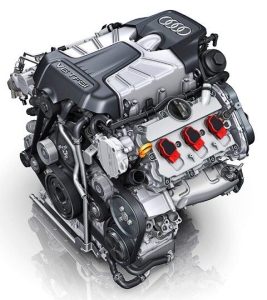The internal combustion engine is the heart of a modern automobile, and understanding its various configurations is key to appreciating the mechanics behind the magic of driving. Among the many engine types, the 4-cylinder engine stands as a popular choice for its balance of efficiency, performance, and affordability. This guide delves into the world of 4-cylinder engines, explaining how they work, their advantages and disadvantages, and the different configurations you might encounter.
Demystifying the Mechanics: How a 4-Cylinder Engine Operates
At its core, a 4-cylinder engine operates based on the principle of internal combustion. Here’s a breakdown of the basic cycle that generates power:

- Intake: A piston inside the cylinder moves downward, creating suction. This suction pulls a mixture of air and fuel (gasoline in most cases) into the cylinder through an intake valve.
- Compression: The piston then moves back up the cylinder, compressing the air-fuel mixture. This compression increases the mixture’s pressure and temperature.
- Combustion: A spark plug ignites the compressed air-fuel mixture, causing a small explosion that drives the piston back down the cylinder. This is the power stroke that generates the force needed to propel the vehicle.
- Exhaust: As the piston reaches the bottom of the cylinder, an exhaust valve opens. The piston pushes the spent exhaust gases out of the cylinder through the exhaust system.
These four steps (intake, compression, combustion, exhaust) occur continuously in each cylinder, creating a cycle that translates to the engine’s overall power output. In a 4-cylinder engine, these four cylinders are arranged in a specific layout, which we’ll explore further in the next section.
Understanding the Layouts: Inline-4 vs. Flat-4 Engines
While the basic operating principle remains the same, 4-cylinder engines come in two main configurations:

- Inline-4 (Straight-4) Engine: This is the most common layout for 4-cylinder engines. The four cylinders are arranged in a straight line, one behind the other, along a single crankshaft. This design is known for its simplicity, compactness, and affordability.
- Flat-4 Engine (Boxer Engine): This less common configuration positions the four cylinders horizontally, opposed to each other, in a flat plane. This layout creates a lower center of gravity, which can improve handling in some vehicles, particularly sports cars. However, flat-4 engines tend to be more complex and expensive to manufacture than inline-4 engines.
The choice of engine layout depends on various factors, including the vehicle’s design goals, performance requirements, and cost considerations.
The Allure of the 4-Cylinder: Advantages and Benefits
4-cylinder engines offer several advantages that make them a popular choice for many car manufacturers and drivers:
- Fuel Efficiency: Due to their smaller size and lighter weight, engines generally consume less fuel compared to larger engines with more cylinders. This translates to lower running costs and a reduced environmental impact.
- Affordability: The simpler design and lower production costs of engines generally make them more affordable than engines with more cylinders. This translates to lower vehicle purchase prices and potentially lower maintenance costs.

- Lightweight and Compact Design: The smaller size and lighter weight of 4-cylinder engines contribute to a vehicle’s overall weight reduction. This can improve handling, agility, and acceleration, especially in smaller cars.
- Adequate Power for Everyday Driving: Modern engines, especially when equipped with turbochargers, can produce sufficient power for everyday driving needs. Advancements in technology have allowed 4-cylinder engines to deliver impressive performance while maintaining good fuel efficiency.
Considering the Drawbacks: Potential Limitations of Engines
While offering numerous advantages, engines also have some limitations to consider:
- Potentially Lower Power Output: Compared to larger engines with more cylinders, 4-cylinder engines may not deliver the same level of raw power, especially when considering high-performance applications.
- Potential for Noisier Operation: The smaller size and fewer cylinders can sometimes result in a slightly higher perceived noise level compared to larger, smoother-running engines with more cylinders.
- Less Towing Capacity: Due to their power limitations, 4-cylinder engines might not be ideal for vehicles that require significant towing capacity.
Beyond the Basics: Variations and Advancements in 4-Cylinder Technology
The world of 4-cylinder engines is constantly evolving. Here are some notable variations and advancements to consider:

-
Turbochargers and Superchargers: These technologies force more air into the engine, allowing it to generate more power without sacrificing fuel efficiency in some cases. Turbochargers utilize exhaust gases to drive the compressor, while superchargers are belt-driven by the engine’s crankshaft.
-
Direct Injection: This fuel injection system sprays fuel directly into the combustion chamber instead of the intake manifold. This can improve fuel efficiency and power output.
-
Variable Valve Timing (VVT): This technology allows for dynamic adjustment of the timing of the intake and exhaust valves, optimizing engine performance across different driving conditions.
-
Cylinder Deactivation: This system can deactivate certain cylinders under low-load conditions, further improving fuel efficiency without sacrificing power when needed.
These advancements showcase the ongoing efforts to improve the efficiency, performance, and overall capabilities of 4-cylinder engines.
Choosing the Right Engine: 4-Cylinder vs. Other Engine Options
The decision between a 4-cylinder engine and other engine configurations depends on your specific needs and priorities. Here’s a brief comparison:

-
4-Cylinder vs. V6 Engines: V6 engines generally offer more power and smoother operation than 4-cylinder engines, but they tend to be less fuel-efficient and more expensive.
-
4-Cylinder vs. Electric Engines: Electric vehicles offer superior fuel efficiency and environmental benefits, but they come with limitations such as charging infrastructure and range anxiety.
-
4-Cylinder vs. Hybrid Engines: Hybrid vehicles combine an electric motor with a gasoline engine, offering a balance between fuel efficiency and power. However, they tend to be more expensive than traditional gasoline-powered vehicles.
Ultimately, the best engine choice depends on your driving habits, budget, and performance expectations. Consider factors like your daily commute length, typical cargo and passenger needs, and desired driving experience.
The Future of the Engine: Embracing Efficiency and Innovation
The 4-cylinder engine remains a dominant force in the automotive industry. With continuous advancements in technology, we can expect 4-cylinder engines to become even more efficient, powerful, and refined in the years to come. These improvements will likely focus on:
- Further Development of Turbocharging and Supercharging Technologies: These technologies hold the potential to unlock even more power and efficiency from 4-cylinder engines.
- Advanced Combustion Technologies: New combustion processes can improve efficiency and reduce emissions from 4-cylinder engines.
- Lightweight Material Integration: Utilizing lighter materials in engine construction can further reduce vehicle weight, enhancing performance and fuel economy.
As the focus on sustainability and fuel efficiency intensifies, the 4-cylinder engine is poised to remain a relevant and adaptable powertrain option for a variety of vehicles.


